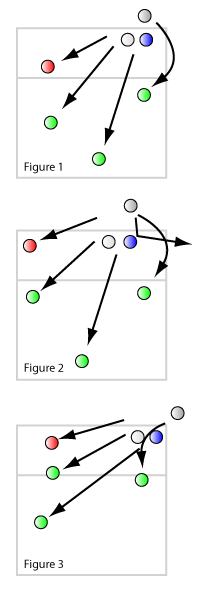Teach possibilities, not positions, to improve court vision
Jeff Putz, January 22, 2005
The more I watch high school volleyball, the more I see that there is an obvious and consistent problem with teams that struggle. This problem has everything to do with kids playing positions instead of possibilities. What does this mean? It means that kids haven't been taught to move beyond the grade six "W" formation. The good news is that it's an easy problem to solve with practice.
The key is to get the kids thinking in terms of possibilities instead of positions. I know that it's tempting for coaches to tell their kids that when the opposition is setting up to hit from a particular place that the defense should move to a series of marks on the floor, but I would challenge them to instead consider the possibilities.

For example, let's say that your opponent is hitting on their left side, just as you would expect for a textbook outside hit. Your kids probably already know how to cover this in the basic sense, regardless of age, but they may not understand the adjustments they have to make and why they're necessary. Set it up for them to show how the defense should be positioned at the very moment that the ball is hit.
Now start moving the hitter around a bit. Figure 1 shows the predictable path of the ball give a tight set to the outside (this defense assumes that the outside blocker won't allow anything down the line, but adjust for whatever your team's capabilities are). In this case we account for a hit through the block, off of the middle's left shoulder, a cut shot over the net, and of course a tip to the back right player. Figure 2 shows the possibilities for a set off the net and slightly more inside. The changes are subtle, but different enough that the defense should shift to consider the new possibilities, including a tooled hit off the outside blocker's right hand. Figure 3 takes it a step further, showing a set way outside of the antenna that forces a very limited number of options upon the hitter. I've seen teams gets burned by this time and time again with a cut down the length of the net because they didn't adjust. It's a lot like having a team hang out at the net when there's an obvious free ball coming your way.
This is where you can make those light bulbs appear over their heads, even for the most stubborn middle hitter playing in the back row. If the coverage simply maintained the original default positions, they would be less likely to pick up whatever the hitter throws at them. Making the adjustments, based on the possibilities, increases the chance that someone can get the dig or cover the tip.
What we're talking about is most commonly called court vision. It's critical to get the kids thinking on their feet, analyzing every situation and responding to it. With time, it becomes almost instinctual for them, but you have to explain it in terms of the actual ball physics instead of positions.
With older kids, you can take court vision a step further by demonstrating tell-tale signs about what kind of hit a hitter will try to put past your defense. There are a great many visual cues that give away a hitter's intention or even cause self-imposed limitations. For example, a hitter that drops their shoulder with the ball behind them is not going to hit down. This weakness can be exploited by knowing that if the blockers can't stop the attack outright, it will likely go off the top of the blockers' hands. That means it's coming right down or it will arc deep into your court. Another example might be the way a hitter jumps. If you see them jumping off of their left foot when approaching the net diagonally and to the right, chances are they're going to pull a basketball lay-up and turn to swing to the left. Video is a great tool to help identify these give-aways.
